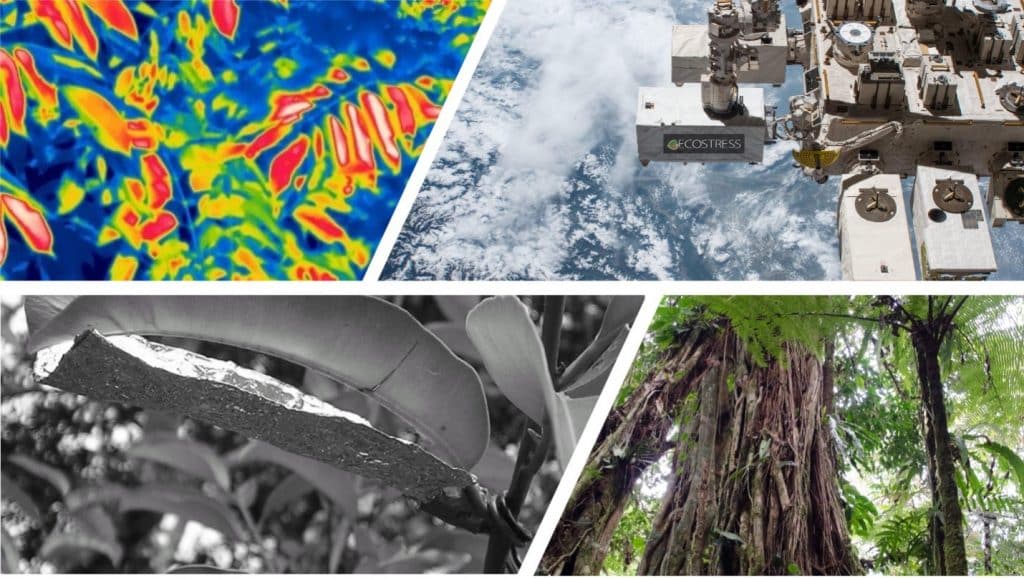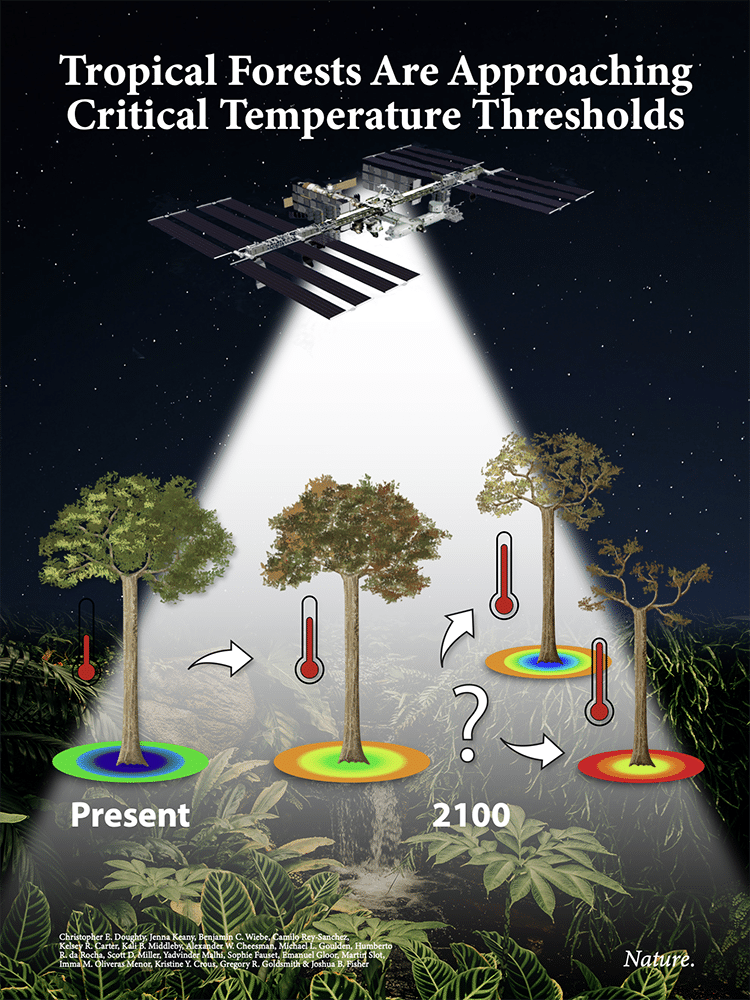On the heels of the warmest month’s on record for planet Earth, a new study found that the world’s tropical forest canopies may be closer to critical high-temperature thresholds than previously known.
The study, which combines satellite thermal and in situ warming experiment data from across the world’s tropical forests, looks at the variation of leaf temperatures within forest canopies. Some individual leaves in a canopy can be much hotter than the mean canopy temperature. The data collected demonstrates that a small percentage of tropical leaves are already reaching, and occasionally exceeding, the temperatures at which they can no longer function—suggesting that as climate change continues, entire canopies could die. These findings have serious implications because tropical forests are home to most of the world’s biodiversity and are key regulators of Earth’s climate.
In the past, accurately measuring tropical forest leaf and canopy temperatures has been difficult and time-consuming. However, by combining ground-based measurements of individual tropical leaf temperatures, leaf warming experiments from three continents and high-resolution data from a new NASA thermal imaging instrument on the International Space Station, lead author Christopher Doughty and his co-authors built a comprehensive understanding of current tropical forest leaf temperatures and model how they may be expected to change given ongoing anthropogenic global warming.
The study, entitled “Tropical forests are approaching critical temperature thresholds,” was published Aug. 23 in Nature.
Among the key results is an estimation of the proportion of leaves that may approach critical temperatures under future increases in air temperatures of 2 degrees, 3 degrees and 4 degrees Celsius (various warming scenarios under climate change). To do so, the study aggregated canopy top leaf warming experiment data from Brazil, Puerto Rico and Australia.
“We were really surprised that when we warmed leaves by just a few degrees, the highest leaf temperatures actually increased by 8 degrees Celsius. This shows a concerning non-linear feedback that we were not expecting,” said Doughty, who is an associate professor of ecoinformatics at Northern Arizona University. The result is that more than 1 percent of the leaves in the canopy warming experiments exceeded critical temperature thresholds, estimated at 46.7 degrees Celsius, at least once a year, increasing the percentage of leaves that surpass this threshold currently by two orders of magnitude.
The authors also measured canopy top peak temperatures across all tropical forests in South America, Africa and Southeast Asia using a new NASA satellite, the ECOsystem Spaceborne Thermal Radiometer Experiment on Space Station (ECOSTRESS), which has the highest combination of spatial and temporal resolution ever and found during dry, warm periods entire canopies could exceed 40 degrees Celsius.
“Historically, we have either studied individual trees to gather data at small scales or used satellite instruments to gather data at large scales. What was missing was a way to collect data at small scales across the tropics,” said co-author Joshua Fisher, who helped launch the ECOSTRESS satellite while working as a NASA scientist at the Jet Propulsion Laboratory (JPL) five years ago and is now an associate professor of environmental science and policy at Chapman University. “That’s where we turn to satellite remote sensing. We were able to measure the temperature of the trees directly at incredibly high resolution, all the way from space, using thermal infrared sensing.”
With high-resolution leaf and canopy temperature datasets in hand, the study then simulated the fate of tropical forests under future climate change warming scenarios. The authors looked at the impact of increased air temperatures and accounted for the possibility of more frequent drought incidence, which further elevates air temperatures and reduces plants’ evaporative cooling ability and accelerates leaf temperatures and tree mortality. As leaves died in the model, they could no longer provide additional cooling, accelerating warming even more.
Under the most likely scenarios, the model predicted that tropical forests could withstand up to 3.9 degrees Celsius of additional climate change-driven warming before leaves experienced a change in metabolic function and potential death. Temperatures above 3.9 degrees Celsius are expected under the “do nothing” global climate change scenario pathways of Representative Concentration Pathways (RCP) 6.0 (when emissions peak around 2080) or 8.5 (when emissions continue to rise throughout the 21st century). The researchers noted that their projections could still shift, as key factors that determine plant death are influenced by both weather patterns such as drought and human activities such as land-use change.
“Our model is not fate,” Doughty said. “It suggests that with some basic climate mitigation, we can address this issue. Further, it helps pinpoint a few key areas that need further research, like whether tropical trees can change their upper-temperature thresholds.” While tropical forest ecosystems are already relatively very warm, previous research has suggested that they are not acclimated to wide temperature swings.
Additionally, the research found that because the Amazon is already experiencing slightly higher temperatures than the Congo Basin, it is at greater risk. In fact, past research has shown that trees are dying at an accelerated rate in the Amazon, compared with Central Africa, suggesting that high temperatures may be partially to blame for this increased mortality.
“Breaching the thresholds for thermal viability of the tropical forest biomes, home to most of the planet’s biodiversity, could be considered a major tipping point for the Earth’s biosphere,” said co-author Yadvinder Malhi, aprofessor at University of Oxford.
Given that tropical forests’ key role in housing species diversity and regulating the planet’s climate, insights into their future can build an understanding of the trajectory of the planet. Doughty emphasized that these worst-case scenarios are more than preventable but would require a significant shift.
“By avoiding high-emissions pathways and deforestation, we can protect the fate of these critical realms of carbon, water and biodiversity.”




